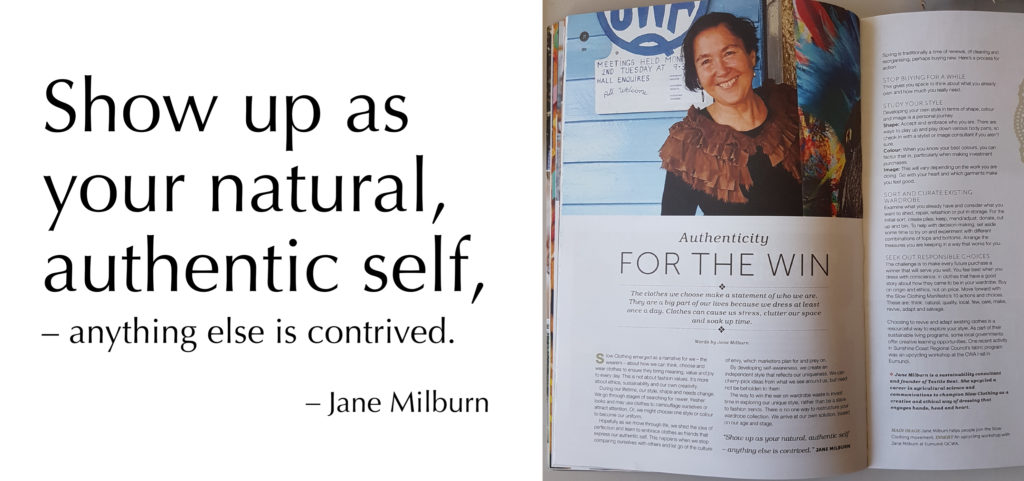‘Show up as your natural, authentic self – anything else is contrived’ – Jane Milburn
The clothes we choose make a statement of who we are. They are a big part of our lives because we dress at least once a day. Clothes can cause us stress, clutter our space and soak up time.
Slow Clothing emerged as a narrative for we – the wearers – about how we can think, choose and wear clothes to ensure they bring meaning, value and joy to every day. This is not about fashion values, more about ethics, sustainability and our own creativity.
During our lifetime, our style, shape and needs change. We go through stages of searching for newer, fresher looks and may use clothes to camouflage ourselves or attract attention. Or, we might choose one style or colour to become our uniform.
Hopefully as we move through life, we shed the idea of perfection and learn to embrace clothes as friends that express our authentic self. This happens when we stop comparing ourselves with others and let go of the culture of envy which marketers plan for and prey on.
By developing self-awareness, we create an independent style that reflects our uniqueness. We can cherry-pick ideas from what we see around us, but need not be beholden to them.
The way to win the war on wardrobe waste is invest time in exploring our unique style, rather than be a slave to fashion trends. There is no one way to restructure your wardrobe collection. We arrive at our own solution, based on our age and stage.
Spring is traditionally a time of renewal, of cleaning and reorganising, perhaps buying new. Here’s a process for action:
- Stop buying for a while: This gives you space to think about what you already own, and how much you really need.
- Study your style in terms of shape, colour and image: Developing your own style is a personal journey. Shape: accept and embrace who you are. There are ways to play up and play down various body parts, so check in with a stylist or image consultant if you aren’t sure. Colour: When you know your best colours, you can factor that in, particularly when making investment purchases. Image: This will vary depending on the work you are doing. Go with your heart and which garments make you feel good.
- Sort and curate existing wardrobe: Examine what you already have and consider what you want to shed, repair, refashion or put in storage. For the initial sort, create piles: keep, mend/adjust, donate, cut-up and bin. To help with decision-making, set aside some time to try on and experiment with different combinations of tops and bottoms. Arrange the treasures you are keeping in a way that works for you.
- Seek out responsible choices: The challenge is to make every future purchase a winner that will serve you well. You feel best when you dress with conscience, in clothes that have a good story about how they came to be in your wardrobe. Buy on origin and ethics, not on price. Move forward with the Slow Clothing Manifesto’s 10 actions and choices. These are: think, natural, quality, local, few, care, make, revive, adapt and salvage.
Choosing to revive and adapt existing clothes is a resourceful way to explore your style. As part of their sustainable living programs, some local governments offer creative learning opportunities. One recent activity in Sunshine Coast Regional Council’s fabric program was an upcycling workshop at the CWA Hall in Eumundi.
First Published in Ruth Magazine Spring 2018
- Jane Milburn is a sustainability consultant and founder of Textile Beat. She upcycled a career in agricultural science and communications to champion Slow Clothing as a creative and ethical way of dressing that engages hands, head and heart.
